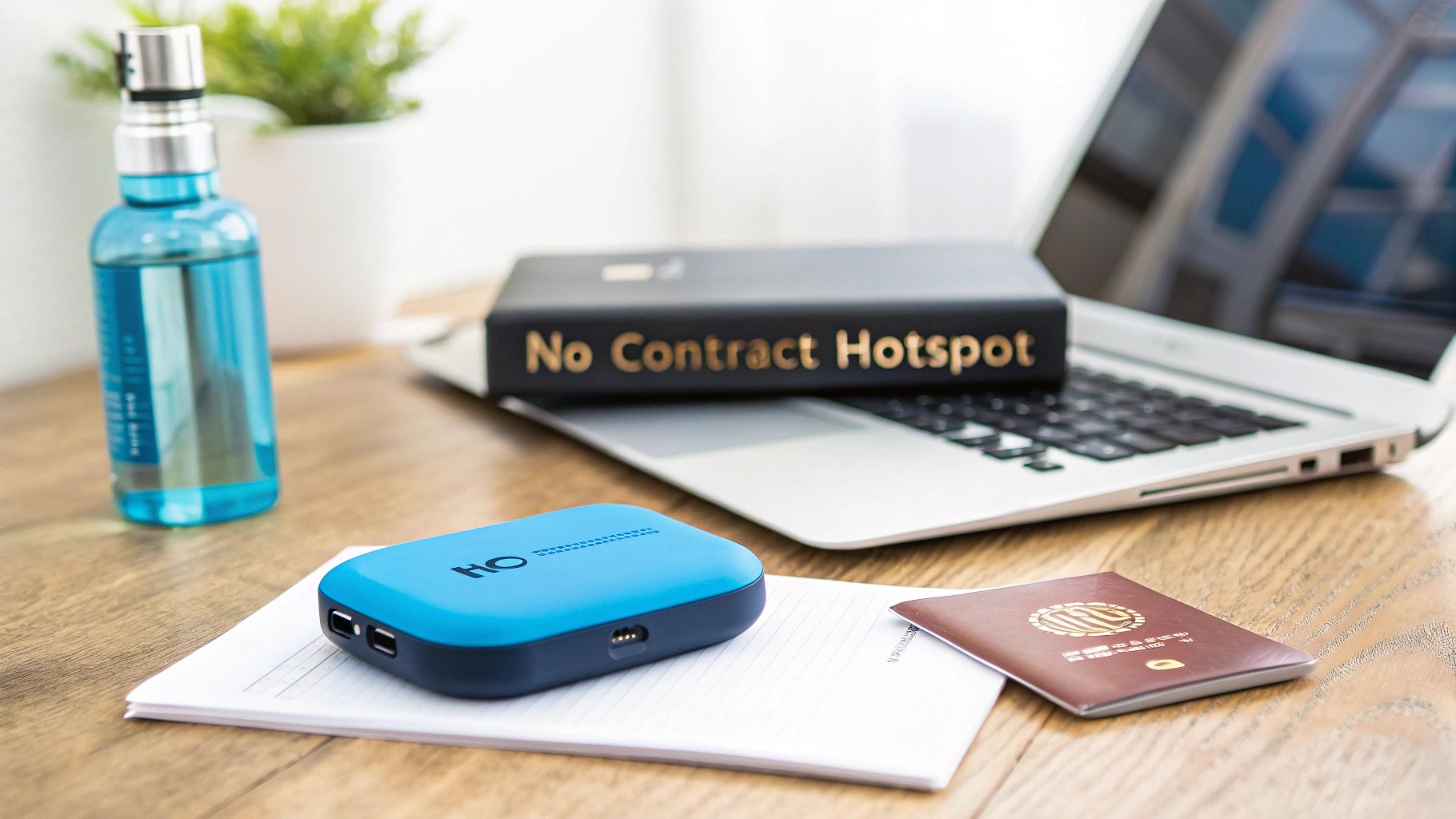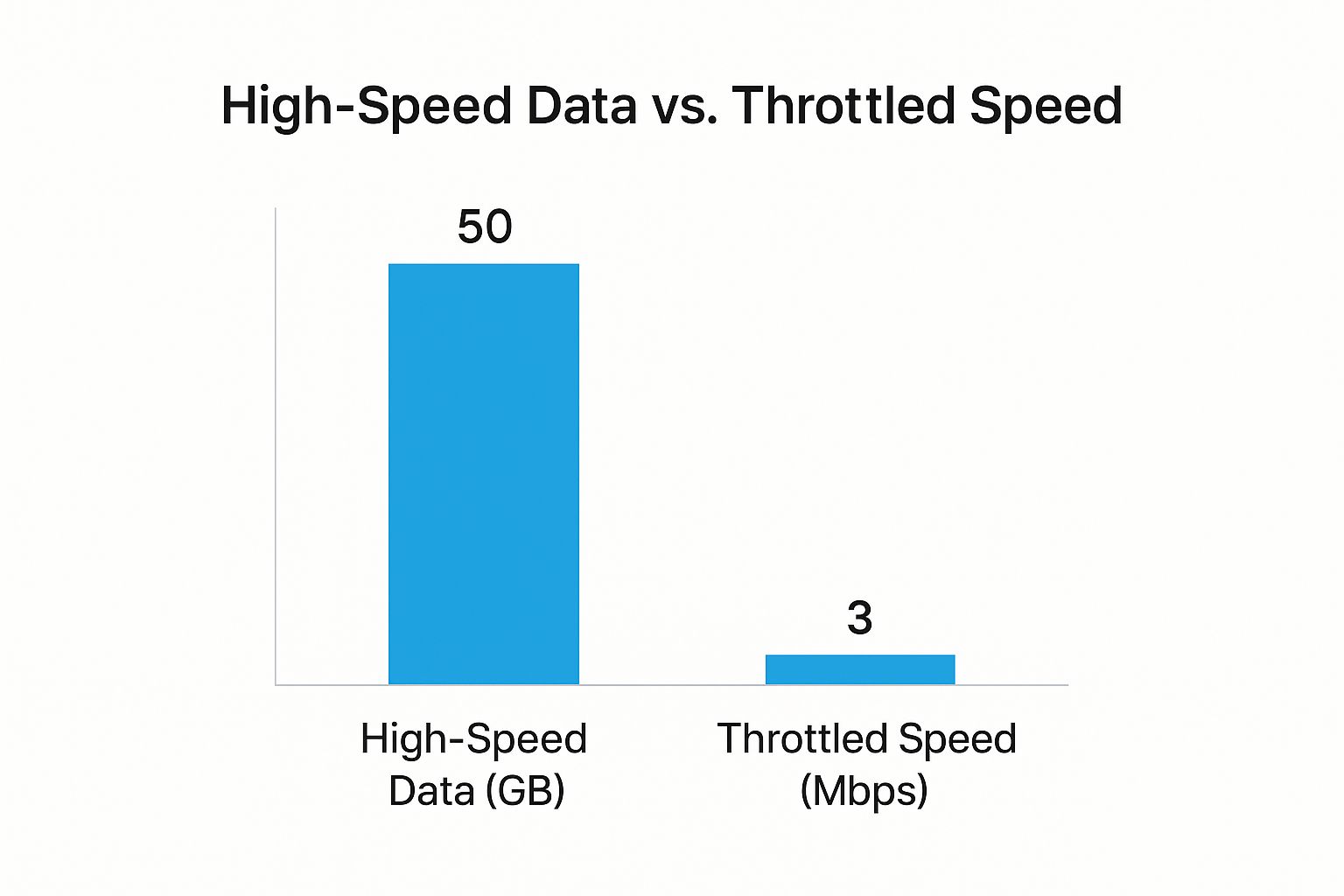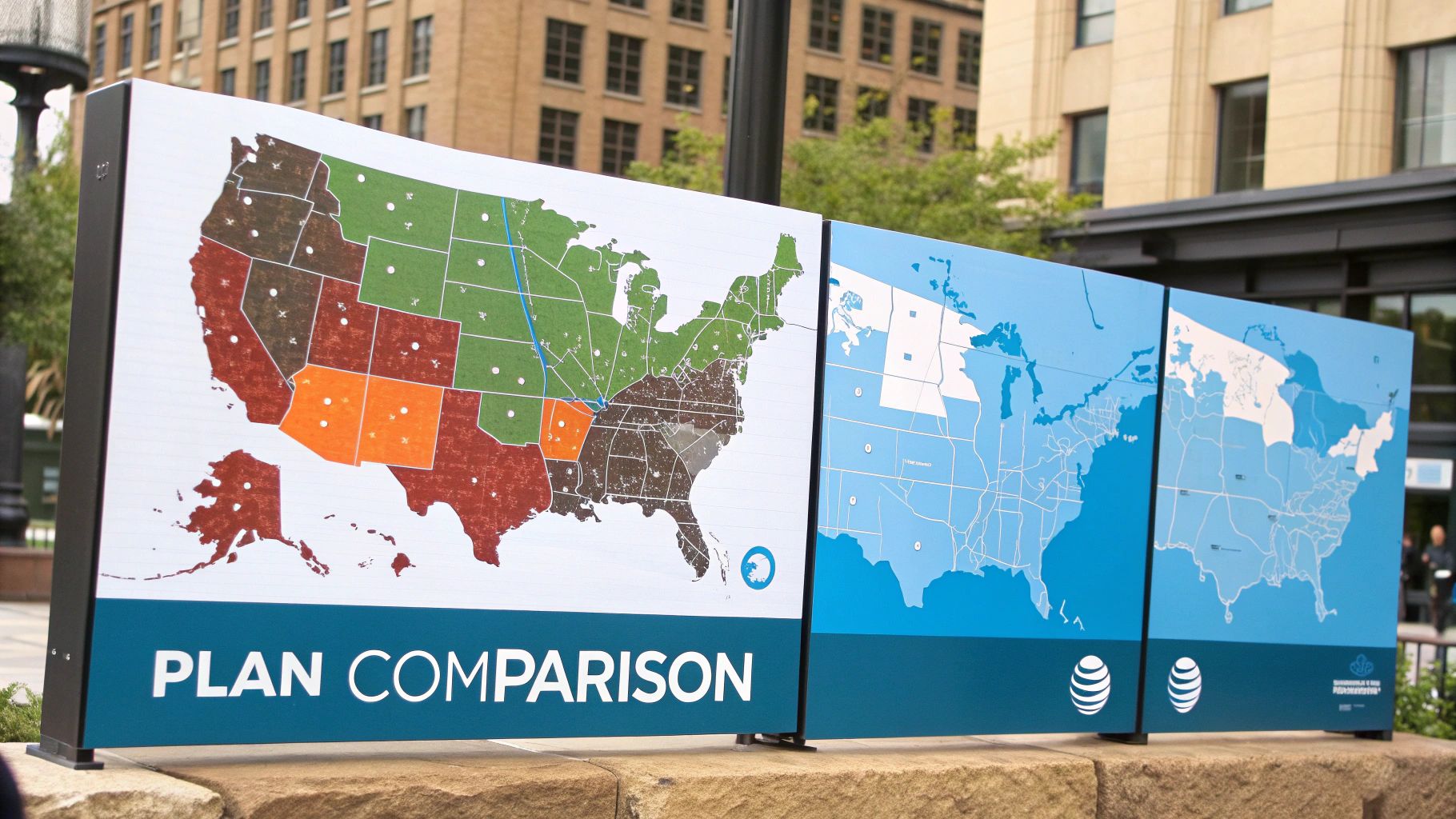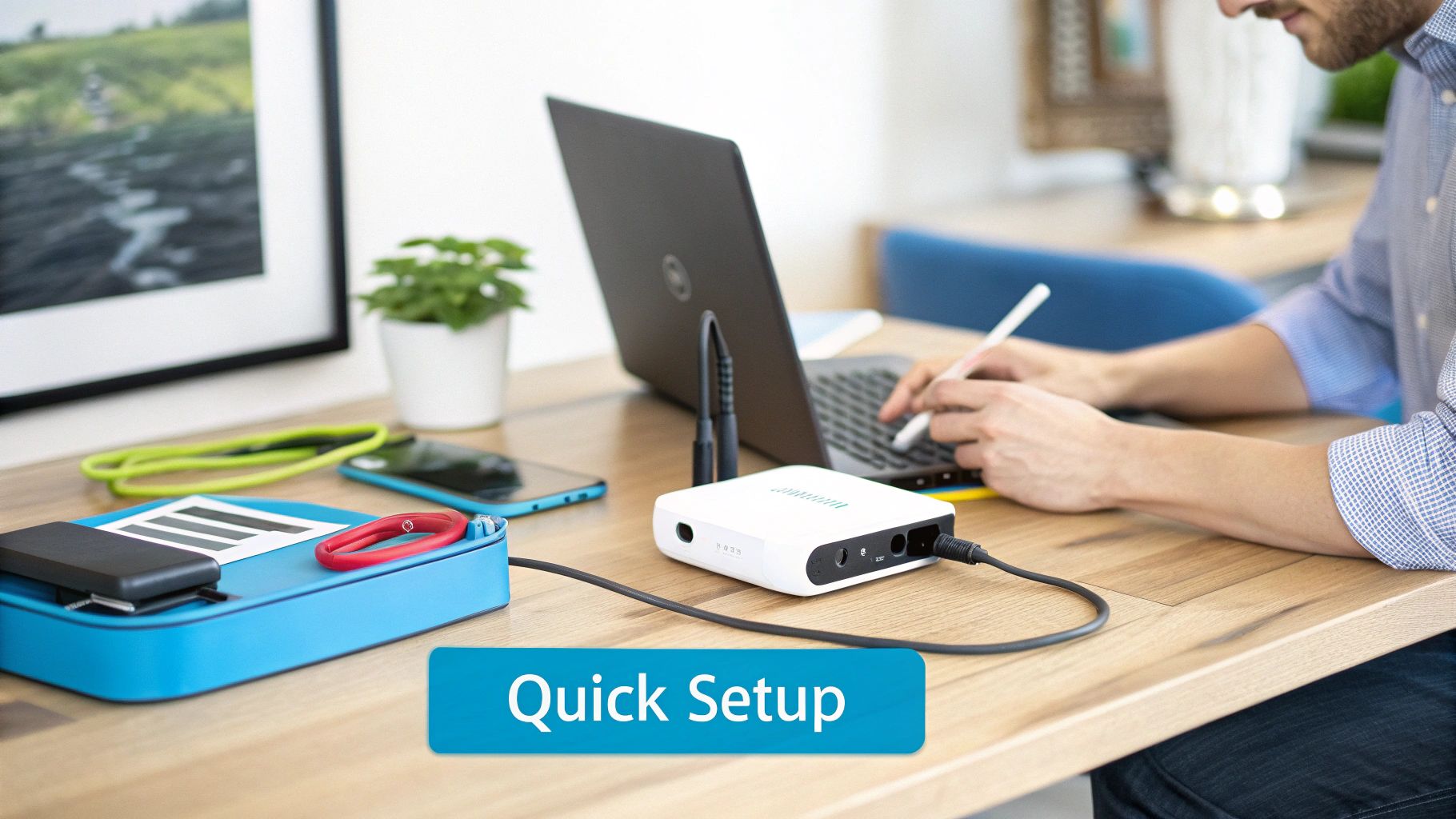

· Por James
Best Unlimited Data Hotspot No Contract Plans
Picking up an unlimited data hotspot with no contract is all about getting internet freedom without being tied down. It's really the perfect setup for anyone who needs solid WiFi that can pack up and go with them—whether that's for travel, working from anywhere, or just having a rock-solid backup connection at home.
Your Guide to Internet Freedom Without Strings Attached

Picture this: you're working from a gorgeous campsite with a mountain view, streaming a movie in your RV after a long day of driving, or making sure your home internet doesn't flake out during a critical video call. Getting that level of connectivity used to mean signing on the dotted line for an expensive, multi-year contract loaded with strict terms and surprise fees. Thankfully, those days are over.
The rise of the no-contract hotspot has totally changed the game. Now, you can get a pay-as-you-go ticket to the internet that you can start, pause, or cancel whenever you feel like it. This guide is here to cut through all the marketing fluff and give you a clear roadmap to what's out there. We'll dig into what "unlimited" actually means and help you pick the perfect plan for your lifestyle.
Why Flexibility Matters Most
Let's be honest, traditional internet plans lock you in, which is a terrible fit if your life isn't static. A no-contract plan, on the other hand, comes with some real-world advantages that just make sense for how people live and work today.
- Freedom to Adapt: Your needs can shift from one month to the next. A no-contract plan lets you upgrade, downgrade, or just walk away without paying a penalty.
- Perfect for Temporary Use: It's a lifesaver for seasonal travelers, students home for the summer, or anyone who just needs a short-term internet fix without a long-term headache.
- You Control the Cost: You only pay for the service when you actually need it. If you're not hitting the road for a month, you can just pause the plan and save your money.
This approach puts you squarely in the driver's seat of your internet costs and service. You'll never get stuck paying for a plan that doesn't fit your life anymore. It’s just a modern solution for a world that's constantly on the move.
For a lot of people, this flexibility is the number one reason to make the switch. If you want to dive deeper into this model, you can learn more about how pay-as-you-go WiFi on the go works and figure out if it's the right move for you. By the time you're done with this guide, you'll know exactly what to look for to get the performance and freedom you need.
Decoding What Unlimited Data Really Means
Let's talk about the single most misleading word in the mobile internet industry: "unlimited." When you see a plan for an unlimited data hotspot no contract, it's natural to think you're getting an endless stream of high-speed internet. The reality, though, is a lot more complicated, and knowing the difference will save you a ton of headaches.
Think of it like an all-you-can-eat buffet. You pay one price for "unlimited" food, but the good stuff—the prime rib, which is your high-speed, premium data—is only for your first plate. After you hit a certain point, all that's left is the salad bar. You're not kicked out, but the quality of your meal takes a nosedive.
The Truth Behind Throttling And Deprioritization
To keep their networks from grinding to a halt, carriers have a couple of tricks up their sleeves. They use these tactics to limit your data speed without actually cutting you off. You'll usually find these terms buried deep in the fine print, but they have a huge impact on your daily internet experience.
- Throttling is the most direct approach. Once you've used a certain amount of high-speed data, say 50GB, the provider intentionally slams the brakes on your connection. Your speed drops to a crawl, often to old-school 2G or 3G levels. It’s like someone turned the volume on your internet down to a whisper, making streaming or even just browsing a painfully slow ordeal.
- Deprioritization is a bit sneakier. This happens when the network is crowded, like during peak hours in a city or at a packed campground. If you've already used a good chunk of your premium data, the network pushes your connection to the back of the line, giving priority to other users. You've essentially been moved into the slow lane during internet rush hour.
So, what you're really getting with an "unlimited" plan is a high-speed data package with an endless supply of slow data tacked on. The most important number to look for isn't the price—it's how much premium data you get before these limits kick in.
This visual drives the point home, showing the stark difference between the fast data you pay for and the slow speeds you're stuck with after you hit that cap.

As the chart clearly shows, once that premium data is gone, the throttled speed is barely usable for modern tasks like video calls or streaming.
This whole industry trend is a response to our growing need for constant, reliable access for streaming, remote work, and gaming. People want predictable costs without worrying about surprise overage fees. You can find more insights into why users are flocking to these plans over on Sellbery.com. Now that you know the lingo, you can read the fine print with confidence and know exactly what you’re paying for.
Comparing the Top No Contract Hotspot Providers

Alright, you get the deal with "unlimited" plans now. Let's get down to brass tacks and see how the big providers actually measure up in the real world.
Picking the right unlimited data hotspot no contract plan is less about grabbing the cheapest deal and more about finding the perfect match for your life. Are you a full-time RVer mapping out remote destinations? A digital nomad who needs rock-solid connections for Zoom calls? The best plan for you is the one that works where you need it, when you need it.
So, let's look past the flashy ads and dig into the one number that truly matters: how much high-speed hotspot data you get before they throttle you. This is what determines whether you can stream, work, and browse without wanting to throw your device out the window.
The Big Three Head-to-Head
The market really boils down to a few major players, and each one brings something different to the table. One might throw a massive amount of high-speed data at you, while another prides itself on having a signal in the middle of nowhere. Nailing down these differences is how you make a choice you won't regret a month down the road.
This constant need for reliable, flexible internet has kicked competition into high gear. As of 2025, the demand for no-contract hotspot plans has exploded. The major U.S. carriers have all stepped up with compelling offers:
- T-Mobile's 'Experience Beyond' plan comes in at around $100 per month and packs a whopping 250GB of high-speed hotspot data.
- Verizon's 'Unlimited Ultimate' plan offers 200GB for about $90 per month, banking on its legendary network reliability.
- AT&T's 'Unlimited Premium' plan gives you 60GB for roughly $86 per month, playing to its strength in broad 4G LTE coverage.
You can dive deeper into these top-tier hotspot data plans to get the full breakdown.
The bottom line is this: each provider is aiming at a different type of person. T-Mobile is for the data hog who lives in 5G territory. Verizon is for the traveler who puts reliability above all else. And AT&T is a solid, dependable choice for a lot of folks in less-populated areas.
To make this easier to visualize, here's a quick comparison of what you can expect from the leading no-contract hotspot plans. This table cuts through the marketing noise to show you the numbers that count—price, high-speed data allowance, and what each network is known for.
Provider Plan Comparison No Contract Hotspots
| Provider | Plan Name | Monthly Price (Approx.) | High-Speed Hotspot Data | Network Specialty |
|---|---|---|---|---|
| T-Mobile | 'Experience Beyond' | $100 | 250GB | Best overall 5G coverage and speed in urban/suburban areas. |
| Verizon | 'Unlimited Ultimate' | $90 | 200GB | Widest network reach, especially in rural and remote locations. |
| AT&T | 'Unlimited Premium' | $86 | 60GB | Strong, balanced 4G LTE network that often covers gaps. |
As you can see, the choice isn't always straightforward. T-Mobile offers an incredible amount of data for the price, but Verizon's slightly smaller data cap might be a worthy trade-off if you frequent areas where T-Mobile's signal doesn't reach.
Key Differentiators to Consider
Beyond just the data, each network has its own personality. Think about where you spend your time, because that's where your connection needs to perform.
-
T-Mobile: If you're a city dweller or stick to the suburbs, T-Mobile is tough to beat. They've been aggressive with their 5G rollout, and it shows in their speeds and data caps.
-
Verizon: For years, Verizon has been the go-to for anyone venturing off the beaten path. If your adventures take you to national parks or down dusty backroads, that legendary coverage can be a lifesaver.
-
AT&T: Think of AT&T as the reliable all-rounder. Its 4G LTE network is a workhorse, often providing a solid signal in places the other two might miss. It's a fantastic middle-ground option.
At the end of the day, a plan with 250GB of data is completely worthless if you can't get a signal. Before you pull the trigger, do the one thing that will save you the most headaches: check each carrier's coverage map for the specific places you live, work, and travel. It's a simple step that makes sure you actually get what you pay for.
Essential Factors for Choosing Your Plan
Picking the right unlimited data hotspot no contract plan is about more than just finding the cheapest monthly price. To avoid buyer's remorse, you have to dig a little deeper. There are a few key things that will make or break your day-to-day experience.
The absolute first thing you need to lock down is network coverage. A massive data plan is completely useless if you can't get a decent signal where you actually need it. This is a deal-breaker for RVers, digital nomads, and anyone living in rural areas where one carrier might be great and the next one is a dead zone.
Before you get tempted by a flashy offer, pull up each provider's coverage map. And don't just glance at the nationwide view. Punch in the specific zip codes for your home, your workplace, and any spots you plan to travel. This one step can save you a world of frustration.
Performance and Device Compatibility
Next up, you have to be honest about the performance you need. The jump from 4G LTE to 5G is pretty significant, especially if you're doing anything that eats up a lot of data. Think frequent Zoom calls for work or streaming your favorite shows in HD. A solid 5G connection will keep things smooth and buffer-free.
That said, for everyday stuff like browsing the web, checking emails, or standard-def streaming, a reliable 4G LTE connection is usually more than enough.
You'll also want to keep an eye on device compatibility. Some carriers will dangle a sweet deal on a plan, but it's tied to buying their specific hotspot device. That’s how they lock you in. If you already have a hotspot you like or just want the freedom to choose your own gear, make sure the plan allows you to "bring your own device." Getting the details on a no-contract mobile hotspot can clear up a lot of these questions.
Uncovering the True Cost
Finally, you need to become a pro at reading the fine print to sniff out any hidden costs. A low sticker price can be mighty tempting, but it often doesn't tell the whole story.
- Activation Fees: A lot of carriers tack on a one-time fee just to get your service started.
- Device Costs: If you have to buy a new hotspot, you need to factor that upfront cost into your total budget.
- Taxes and Surcharges: The price you see advertised is almost never the final price. Always account for government taxes and regulatory fees.
The bottom line is that real value isn't just about the lowest monthly payment. It's about finding that sweet spot of enough data, reliable speed, and solid coverage—all for a price that doesn't surprise you.
For example, AT&T’s 'Unlimited Extra EL' plan gives you 30GB of hotspot data for about $76, while Verizon’s $80 'Unlimited Plus' plan matches that hotspot data but throws in unlimited premium cellular data. T-Mobile, on the other hand, offers a whopping 250GB hotspot cap, but you’ll pay for it at $100 a month. It shows how carriers are all playing a balancing act between network capacity and cost. By looking closely at all these factors, you can find a plan that actually gives you the freedom and performance you're paying for.
Getting Your No Contract Hotspot Up and Running

You've done the research and picked out the perfect plan. Now for the easy part: bringing your new unlimited data hotspot no contract device to life. Don’t worry if you don’t consider yourself tech-savvy—the whole process is designed to be ridiculously simple, getting you online in just a few minutes.
Think of it like setting up a new phone. The first thing you'll do is unbox everything and plug the hotspot in for a full charge. A topped-off battery is your best friend for reliable performance, especially when you're on the move.
Your Quick-Start Connection Guide
Once your device is fully juiced up, the next steps are a breeze. You’ll pop in the SIM card that came from your provider, then follow their instructions to get the plan activated, which is almost always handled online.
- Activate Your Plan: This usually means hopping on the provider’s website and typing in your SIM card number. The whole thing is automated and typically wraps up in just a couple of minutes.
- Power On and Find Your Network: Flip the hotspot on. Just like your home router, it will start broadcasting a WiFi signal. Grab your laptop, tablet, or phone and look for a new network name (the SSID), which is usually printed right on the hotspot.
- Enter the Password and Connect: The default WiFi password will also be on a sticker on the device. Punch that in, connect, and that’s it—you're online and ready to roll.
Pro Tips for a Better Experience
Getting online is one thing; making sure your connection is fast and secure from day one is another. A few small tweaks right at the beginning can make a world of difference in your daily use and give you some extra peace of mind.
Taking just five extra minutes to optimize your setup can seriously boost your signal strength and keep your personal data safe from prying eyes.
Here are a few best practices to get into the habit of right away:
- Change the Default Password: The password printed on your device is generic and not very secure. Log into your hotspot’s settings (usually through an app or a web browser) and create a strong, unique password that only you know.
- Find the Best Spot: For the strongest signal, place your hotspot near a window where it has a clear line of sight. Try to avoid tucking it away in a drawer or cabinet, as that can block the cellular signals and really slow you down.
- Monitor Your Usage: Use your provider’s app to keep tabs on how much high-speed data you’re using. This is a great way to avoid hitting your cap by surprise, and it’s especially helpful if you're thinking you might use your hotspot as a home internet replacement.
Wrapping It Up: Making the Right Choice for Your Digital Life
So, what's the verdict on the best unlimited data hotspot no contract plan? Well, if there’s one thing to take away, it’s that there's no single magic bullet. The "best" plan is deeply personal, and it all comes down to what you actually need it for—whether you’re a full-time RVer, a remote worker setting up shop in a new city, or just someone in a rural area who’s fed up with spotty internet.
When you start digging into the options, a few critical truths quickly become clear. First off, "unlimited" rarely means what you think it means. You have to look past the flashy marketing and find the real number: the premium data allowance. That figure is what truly dictates your online experience.
Key Takeaways for a Confident Decision
This number tells you exactly how much high-speed streaming, browsing, and video conferencing you can burn through before your connection gets knocked down to a crawl. Think of it as your high-speed fuel tank.
Next up, coverage is king. A plan with a massive data cap is completely worthless if you can't get a signal where you need it most. Before you even think about signing up, pull up the provider's coverage map and zoom in on the specific places you live, work, and travel. Finally, once you have that info, you can compare plans based on their high-speed data allowance, not just the monthly price tag. A slightly more expensive plan with double the data is often the better deal.
- For Digital Nomads: Look for providers with strong 5G networks, especially if you stick to urban and suburban areas where the speeds are highest.
- For RV Travelers: Your best bet will likely be carriers known for extensive rural coverage, like Verizon. Their network often reaches places others don't.
- For Home Backup: You probably don't need a massive plan. A moderate data cap can give you an affordable safety net for when your main internet goes down.
You’re now equipped to see beyond the advertising hype and pick a plan that genuinely fits your life. This isn't just about buying internet; it's about securing your connection to work, family, and entertainment, wherever you happen to be.
The journey to find flexible, powerful internet doesn't have to be complicated. You have the tools to make a confident choice, break free from those restrictive contracts, and get connected on your own terms.
Frequently Asked Questions
Even after digging into the details, you probably have a few questions rolling around your head about picking the right unlimited data hotspot no contract plan. Let's tackle the most common ones head-on so you can make your final choice with complete confidence.
Can I Just Use My Smartphone Instead of a Dedicated Hotspot?
You can, but you're probably going to regret it if you need a serious connection. Using your phone’s built-in hotspot is fine in a pinch for some quick browsing, but it’s just not built for the heavy lifting of full-time travel or remote work.
A dedicated hotspot is engineered for one job: delivering a solid, stable internet connection. They pack more powerful antennas to grab weaker signals, have batteries that last for hours without killing your phone, and can handle way more devices at once. For anyone who travels frequently or works from the road, a dedicated device is almost always the smarter, more reliable choice.
What Really Happens When I Run Out of High-Speed Data?
This is the single most important thing to get your head around. Once you burn through your high-speed data allowance (let's say it's 60GB), your connection gets "throttled."
You won't be disconnected or slapped with surprise charges—that's the "unlimited" promise. But your speeds will be knocked down to a crawl, usually to 2G or 3G levels. At that point, forget about streaming video, joining a Zoom call, or even loading a website with lots of pictures. You’ll still be able to squeak by with basic emails and messages, but your internet will feel agonizingly slow until your plan resets for the next month.
Think of it as your internet switching from a highway to a gravel road. You're still moving, but the journey becomes a lot slower and more frustrating for anything beyond the absolute basics.
Is a No-Contract Hotspot a Good Replacement for Home Internet?
It absolutely can be, but it really boils down to your lifestyle. For a single person, a couple, or anyone with moderate internet needs, a powerful hotspot can be a fantastic, flexible alternative to traditional cable. It's a perfect fit for renters, people who move a lot, or folks stuck in areas with lousy wired internet options.
But for a large family where everyone is streaming 4K movies, gaming online, and running a house full of smart devices all at once? A hotspot plan is probably going to hit its high-speed data limit and leave everyone frustrated with slowdowns.
Ready to get reliable, high-speed 5G internet that travels with you? SwiftNet Wifi offers powerful no-contract plans designed for RVers, rural residents, and remote workers. Check out our solutions and get connected today at https://swiftnetwifi.com. #rv #rvlife #rvliving #rvlifestyle #rvrenovation #rvremodel #rvtravel #rvcamping #rvadventures #ruralwifi #5gwifi #5ginternet

